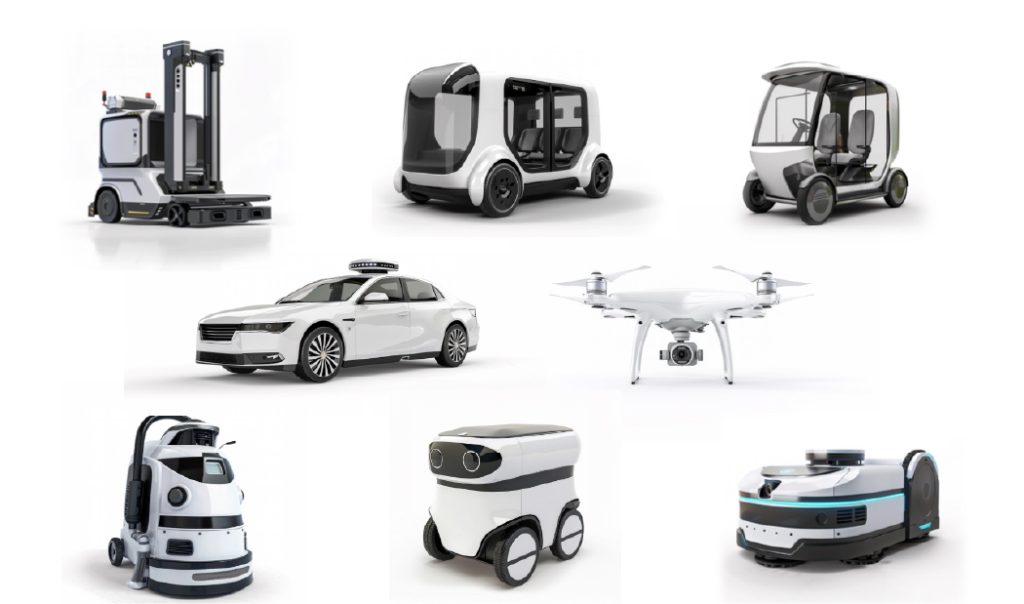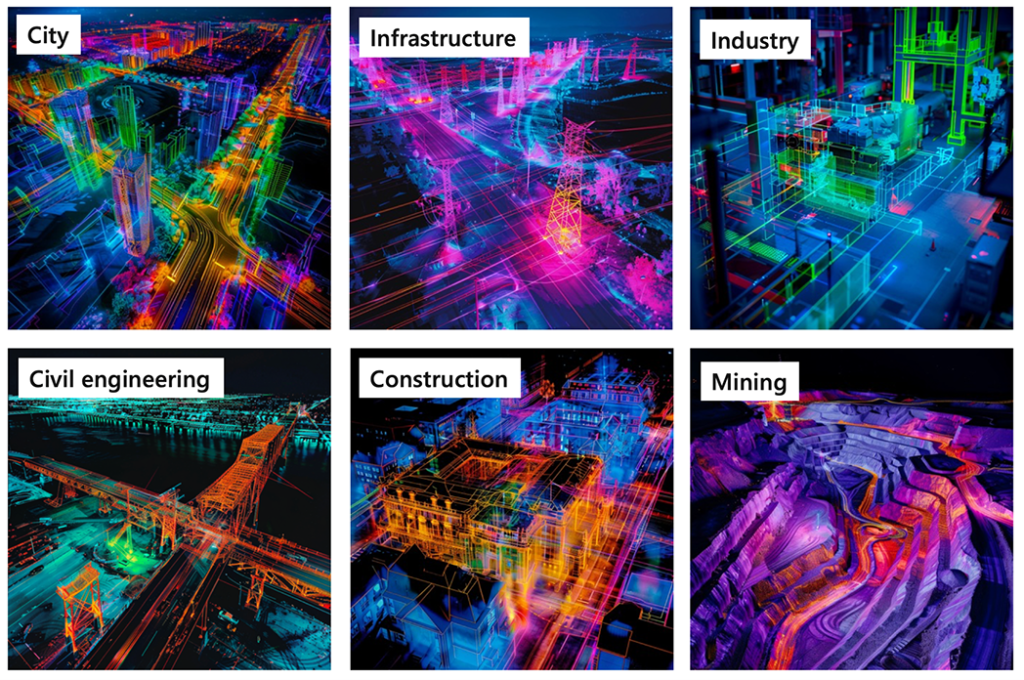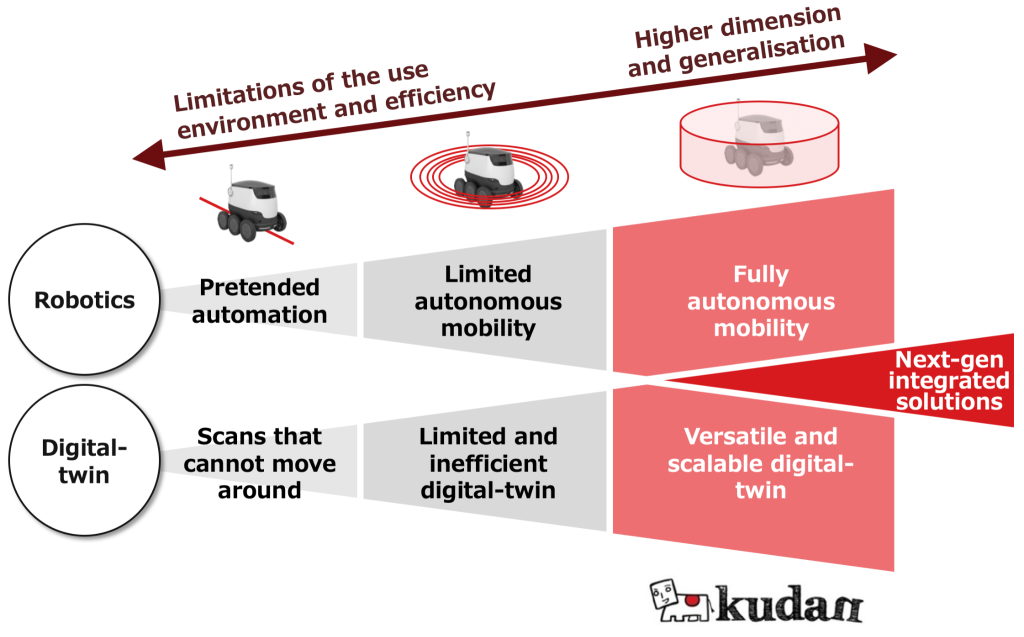2
Robotics and digital-twins changing the world
Having eyes enables machines to understand and move around the world
Machines equipped with Artificial Perception (AP), the “eyes of the machine”, can understand and move around the world. This video shows how the car uses visual information to understand and explore its environment.
This shows how the car understands the structure of the underground car park in real time, understanding its own position and movements as it drives from outdoors and directly into the underground car park. The 3D map visible is not pre-made but is generated and expanded as the car moves around, similar to how a dungeon is explored in an RPG game to explore the world.
Machines that robotize by having eyes
Just as humans need eyes to move around freely, Artificial Perception (AP), the “eyes of the machine,” is a spatial technology essential for robots and computers to understand and move around in real environments and to achieve fully autonomous mobility, driving, and flight.

Thus, the robotization of machines with eyes has enormous potential in a wide range of fields, from robots that support work and logistics in industry to self-driving cars that help people get around, flying drones, and robots engaged in services, all of which will be robots supported by Artificial Perception (AP).
Worlds that digitize by machine’s eyes
Artificial Perception (AP) can also easily convert real space into three-dimensional digital information by moving around and scanning real space as the “eyes of the machine”.
Whether indoors or outdoors, where people move around, cars drive around, drones fly around, etc., by scanning any environment with a device embedding Artificial Perception (AP) technology, you can generate a digital-twin that is an exact virtual copy of the actual space.
Thus digital-twin can be used to enable digital transformation of spatial information.
Digital transformation of spatial information through digital-twinning

Digital-twins are currently attracting attention and development in many industries, including city, infrastructure, industrial, civil engineering, construction and mining. For example, the complete digital transformation (DX) of all the types of planning processes based on 3D information, such as urban planning, construction planning, and facility change and operation planning at plants, can significantly improve its efficiency. In addition, in all facility management operations such as inspections and maintenance, digital-twin can significantly enhance the efficiency of information-sharing operations by creating a database linked to 3D information as in real space. The digitalised copy of the real space is expected to serve as the technical platform for all next-generation and new digital transformation (DX) solutions and solutions.
Kudan’s vision for next-generation solutions
Various efforts have been made in conventional approaches before Kudan unlocks next-generation robotics and digital-twin applications through Artificial Perception (AP).
For example, in indoor robotics, robots have moved along magnetic tapes or understood the environment only on a two-dimensional plane, while in outdoor robotics, they have recognised their position with high-precision GPS or learnt road lanes with artificial intelligence (AI) and relied on that recognition, all of which have faced significant limitations.
Those approaches are very similar to those of a blind person who uses a walking stick, braille blocks, and handrails or can only understand learnt patterns. Although those approaches can work to a certain degree within the constraints, without true vision-based spatial perception (sense of direction and sense of movement), those applications are still far from humans’ capability.
As a result, those robots can only work in less than 10% of the environments that humans are capable of dealing with, because those robots are usually immobile or have limited mobility in brand-new or unprepared spaces, wild and complex environments, and GPS-blocked areas. Furthermore, even in those limited environments, the cost of assisting “robots that are not fully visible” is high due to environmental maintenance and other costs, which makes it very difficult to replace humans practically.

Similarly, for digital-twins, conventional technologies are inevitably limited in their ability to scan and move around. These limitations include the speed and scalability of the point cloud generation, the cost of the mapping operations, the requirement for some dedicated and high-cost sensors, and the inflexibility of the map expansion and update for maintenance. All of those constraints limit the practical penetration of digital-twn applications.
Kudan’s Artificial Perception (AP) aims to remove the limitations and inefficiencies of existing robotics and digital-twin approaches by replacing the machine’s perception with true eyes. This will enable robots that can move fully autonomously and digital twins that are practical and scalable.
Robotics and digital twins can then evolve as the ‘eyes of the machine’ perceive the world, opening up new possibilities for machine understanding of the real world and interacting with humans. Together, these two areas will form an enormous market worth at least several trillion dollars, and Kudan will support and accelerate their development.